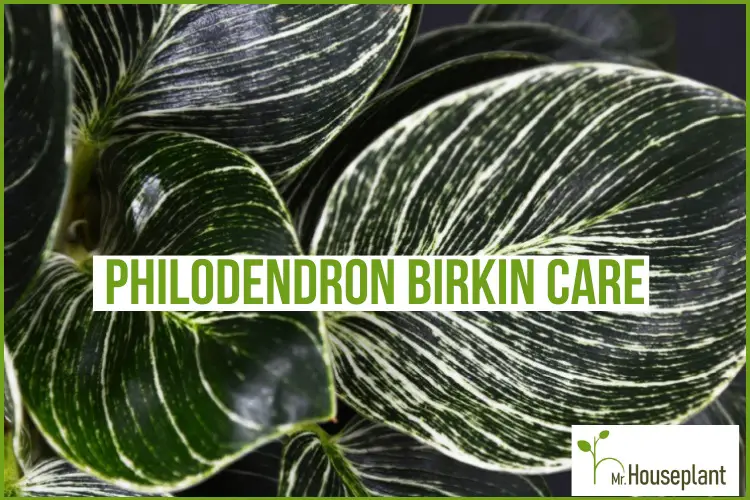
Would you like to learn how to care for your Philodendron Birkin plant? After reading this comprehensive guide, which covers everything from light and temperature requirements to fertilizing, repotting and the most common pests, you will be able to care for Philodendron Birkin like a pro.
| Botanical Name (Latin Name/Scientific Name): | Philodendron birkin |
| Common Name: | Philodendron ‘White wave’ |
| Light: | medium light (750 lux to 3,000 lux or more) |
| Watering: | when the top 2″ are dry for smaller plants/once the top half of the soil is dry for larger plants |
| Soil: | well-draining mix |
| Repotting: | Once a year |
| Temperature: | 65ºF (18ºC) to 85ºF (29ºC) |
| Humidity: | 25% to 50%, but it adapts well to lower humidity |
| Toxicity for Pets: | Yes |
| Toxicity for Humans: | Yes |
| Propagation: | stem or tip cutting/division/air layering |
| Pruning: | prune dead or diseased growth or when you want the plant to branch out |
About Philodendron Birkin
Philodendron Birkin is a member of a large Philodendron genus, alongside about 500 other species. Philodendron plants are native to South America and they can be divided into two types: vining and self-heading. Vining philodendrons climb towards trees, whereas the self-heading ones grow upright. Birkin is a self-heading philodendron type, boasting variegated lush dark green leaves streaked with vivid yellow or white pinstripes.
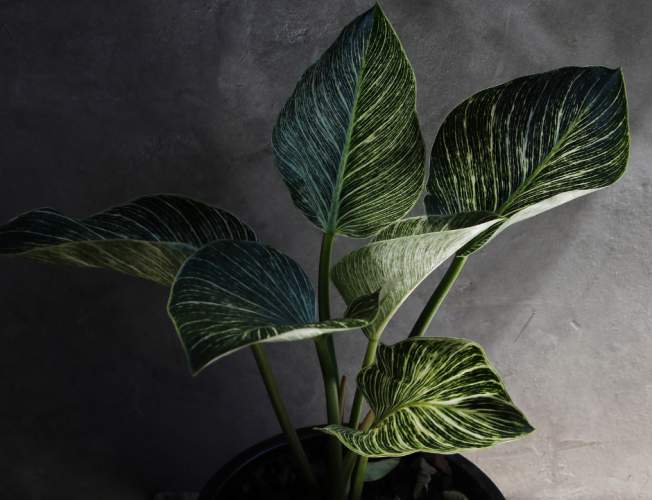
Philodendron Birkin with gorgeous creamy white variegation
The story of the origin of this striking plant is quite interesting. Philodendron Birkin can’t be found in the wild, and it is a result of a rare spontaneous mutation on a Philodendron ‘Rojo Congo’. The plant was then separated and cultivated. Birkin became trendy due to its distinctive foliage and since Philodendron Birkin care isn’t too complicated, this plant is also a great choice for new plant parents.
Philodendron Birkin Care and Growth
Light Requirements
| Minimal amount of light: | 1,000+ lux (100+ FC) |
| Optimal amount of light: | 2,500+ lux (250+ FC) |
| Direct sun tolerance: | 2-3 hours |
| Category: | medium light |
Philodendron Birkin does best in medium light. It needs a minimum of 1,000 lux (100 FC) of medium indirect light, but to optimize your plant growth, strive for at least 2,500 lux (250 FC). Birkins can tolerate 2-3 hours of direct sun, in the early morning or very late in the afternoon.
Like with other variegated plants, it’s important to find balance when it comes to light if you want to have good variegation. You don’t want to scorch or bleach your plant’s beautiful leaves with too much direct sun, but you also don’t want the variegation fading due to lack of light. If you can’t provide enough natural light, the best way to give your Birkin optimal light is to place it on a shelf with grow lights.
Water Needs
Optimal hydration is one of the key elements when it comes to Philodendron Birkin care. Philodendron plant that is smaller, should be watered when the top two inches of soil dry out. If you have a larger plant, wait until the top half of the soil is dry, before hydrating your Birkin.
Birkin plant watering schedule will depend on conditions in your home, such as humidity, temperature, etc. It’s important to check if the soil is dry before watering your Philodendron Birkin. Overwatering can lead to root rot, while underwatering can cause your leaves to wilt.
Excess water can cause overly moist soil. Since the Philodendron Birkin plant doesn’t like too much moisture, ensure that its container has drainage holes.
Best Soil for Philodendron Birkin
To make the best soil for your Philodendron Birkin mix the following:
- 2 parts of any commercial potting mix
- 1 part of perlite or another inorganic amendment
If you use amendments like perlite, bark, gritty sand, pumice, and vermiculite you will prepare an excellent Philodendron Birkin soil mix. They make soil airy and porous because they have large particles that create macro pores. Macro pores contain oxygen, which is vital for plant roots. Roots that get enough oxygen are vigorous and less susceptible to root rot and fungal infections. The amendments also ensure proper drainage, which is very important, since plants that sit in soggy soil have a higher risk of suffering from root rot.
Humidity Needs
Although Philodendron Birkin plant can’t be found in nature, it’s a member of the Philodendron genus, like other tropical plants belonging to this genus, it enjoys medium humidity, from 25% to 50%. It’s not very demanding when it comes to humidity, and your Philodendron Birkin will do absolutely fine even in lower humidity levels.
If you ever need it, one of the Birkin care tips is to use a pebble tray and humidifier to increase humidity.
Temperature Requirements
The optimal temperature range for Birkins is from 65ºF (18ºC) to 85ºF (29ºC). Since Philodendrons prefer warmer temperatures, it’s important to protect them from cold and frost. Birkin plants are kept as a houseplant, so the regular temperature in your household will be great for them. If you’re comfortable in your home, your Philodendron Birkin will also be comfortable.
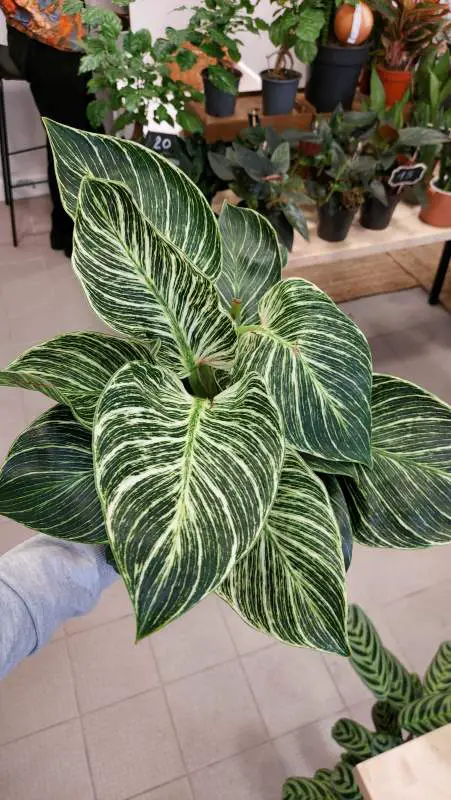
Philodendron Birkin growing under optimal conditions displays striking white variegation
Fertilizing
If you repot your Philodendron Birkin once a year, you don’t have to fertilize it, since the fresh soil will give your plant the necessary nutrients. If you want to fertilize your Birkin, you can do it by using a high-quality liquid fertilizer, such as The Sill fertilizer, which has a great N-P-K ratio of 3:1:2 that is excellent for foliage plants. Always read the instructions on the fertilizer packaging, to avoid accidentally overfertilizing your plant.
You don’t need to wait for its growing season in spring and summer to fertilize your Birkin, as long as it’s actively growing, you can go for it. Fertilize your plant only when it’s actively growing so it can absorb the nutrients properly. If your plant isn’t actively growing, excess minerals from the fertilizer will accumulate in the soil and can burn the roots.
Repotting
If you want to repot your Philodendron Birkin, take the following steps:
- Select a pot that is one size bigger than the one you’ve been using
- Fill the pot up to one-third with well-draining potting soil
- Take your Birkin gently out of its pot
- Loosen the rootball
- If the roots are mushy, smelly or rotten, prune them
- Put your Philodendron Birkin in its new pot
- Fill in the space with soil
- Press firmly around the plant and water it
The rule of thumb is to repot your Philodendron plant annually, or when you notice that the plant has run out of space. You can check the drainage holes, and if you see that the roots are poking out, it’s time to repot your Birkin plant and provide it with fresh, non-compacted soil.
Only go one size up (2” up in diameter) when choosing a new pot. If you get a pot that’s too big it will contain too much soil, which would take longer to dry out. This could lead to root rot eventually.
Philodendron Birkin Toxicity for Humans
Philodendron Birkin is toxic to humans, according to California Poison Control System. The sap and juice of Birkin plants contain calcium oxalate crystals, which can irritate the oral cavity. They can also cause throat swelling and breathing difficulties.
Philodendron Birkin Toxicity for Pets
Like other Philodendrons, Philodendron Birkin plants are toxic to cats and dogs, according to ASPCA. It’s important to keep the plant out of the reach of your pets since it can cause irritation of the mouth and tongue and provoke drooling, vomiting, or difficulty swallowing.
Pruning
You can prune your Philodendron Birkin plant if it has dry and dead, diseased or brown leaves. You can also prune if you want your plant to branch out. In that case, just cut off the top of the stem, and the plant will branch out below the cut. Diseased parts of the plant should be promptly removed to stop the further spreading of the disease.
If your Philodendron Birkin is healthy, it’s not necessary to prune it.
Philodendron Birkin Propagation
You can propagate your Philodendron Birkin using one of the following techniques:
- Stem/tip cuttings
- Division
- Air layering
Propagation by Stem/Tip Cuttings in Water
The simplest way to propagate your Philodendron Birkin is by stem/tip cuttings in water, with the following steps:
- Sterilize your shears or scissors to avoid accidentally infecting your plant
- Pick a sturdy and healthy stem
- Cut about an inch below the growth node, make sure that your stem cutting has at least two growth nodes (node is a part from which a plant’s leaf grows)
- Remove the leaves of Philodendron Birkin from the lower half of the stem cuttings (no leaves should be submerged in the water)
- Put the cutting in a glass container with water
- Place the glass container in a warm spot with lots of bright, indirect light
Replace the water weekly or more often if you notice that it’s smelly or murky. After a couple of weeks the roots will be an inch or two inches long, and at that point you can plant the cutting in soil.
Philodendron Birkin Pests And Diseases
Pests
Although Philodendron Birkin plants are generally pest-free, they can become infested with mealy bugs, spider mites, or aphids. Philodendron Birkins that receive good care (proper light, watering and potting mix) are less susceptible to pests.
Mealybugs look like white, cottony masses on the surfaces of leaves, and they feed on plant sap. The infested plant’s growth is stunted, and in severe cases, some parts of the plant begin to die.
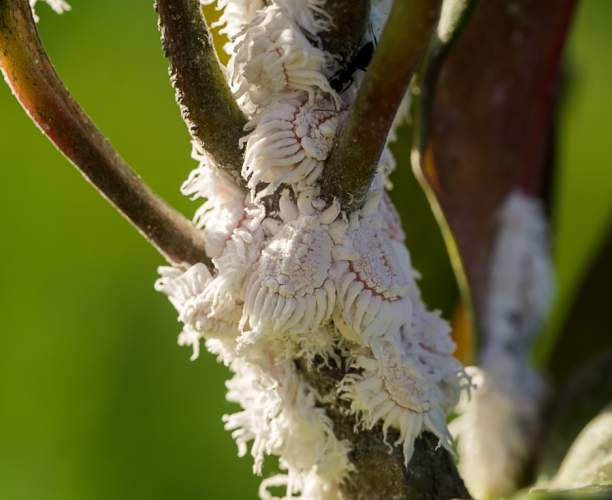
Mealy bugs feeding on plant sap
Spider mites are really small and hard to spot. A silky web is usually seen with more severe infestations. They damage the plant by sucking the sap. The leaves of the infested plant become yellow or bronzed. Neem oil is a great remedy against spider mites.
Aphids are small insects with soft bodies, usually green, but they can be brown, pink, or yellow. They feed on new growth and on the leaves. Aphids suck Philodendron Birkin plant’s sap which causes the leaves to become yellow and deformed.
Luckily, if you carefully monitor your Philodendron Birkin, and notice the pests early on, you can usually resolve the issue by handpicking. You can also forcefully spray water to remove the pests, just make sure to spray the entire plant.
Fungal Diseases
The most common fungal diseases affecting Philodendron Birkin are:
- Phytophthora leaf spot – causes brown lesions, the best prevention is to grow plants in sterilized potting media
- Pythium root and stem rot – causes yellowing and wilting of Birkin leaves, and mushy roots, the best prevention is to ensure the soil is porous, non-compacted, and well-draining
- Southern blight – causes white cotton-like masses, the best prevention is using pathogen-free potting medium
You can find more info on philodendron diseases on the University of Florida website.
Philodendron Birkin Common Problems
Leaves Turning Yellow
Your Philodendron Birkin plant leaves may turn yellow due to aphids, spider mites, overwatering, underwatering, or it can be normal leaf senescence (older leaves dying). Inspect your plant and if you see any pests, treat the plant with insecticidal soap or horticultural oil. To prevent yellow leaves from overwatering or underwatering, water your Philodendron Birkin once the top two inches/top half of the soil are dry. If the previously listed reasons aren’t causing yellow leaves, it is leaf senescence – older leaves turn yellow and die as the plant grows new leaves.
Brown Tips
Brown tips can be caused by underwatering, very low humidity or too much fertilizer.
Healthy Dropping Leaves
Healthy leaves dropping can be caused by pest infestation, such as thrips. Thrips are small and slender yellow-to-black insects usually found on Birkin leaves. They scrape the surface cells of the plant to suck the sap. The affected Philodendron Birkin leaves will be speckled, and they may drop early. You can get rid of thrips by using a systemic insecticide.
FAQs about Philodendron Birkin
What’s the Difference Between Philodendron Birkin and Philodendron Rojo Congo?
The difference between Philodendron Birkin and Philodendron Rojo Congo can be easily spotted by comparing their leaves. The young leaves of Rojo Congo are red, and as they mature they turn to burgundy-green leaves with red petioles and stems. On the other hand, Philodendron Birkin has creamy yellowish pinstriped variegation.
Is Philodendron Birkin Rare?
Philodendron Birkin is not as rare as it used to be, due to its increasing demand and popularity. Many plant shops have started to include Philodendron Birkin in their collections.
Why Is the Variegation Fading On My Philodendron Birkin?
Variegation on your Philodendron Birkin is fading either due to insufficient bright indirect light, or because it’s starting to revert to Philodendron ‘Rojo’. Philodendron Birkin reverting to Rojo can happen when your plant doesn’t have optimal growing conditions. If your plant is reverting, you should cut it back to the last leaf that is fully variegated and hope that the new Philodendron Birkin leaf will be variegated.
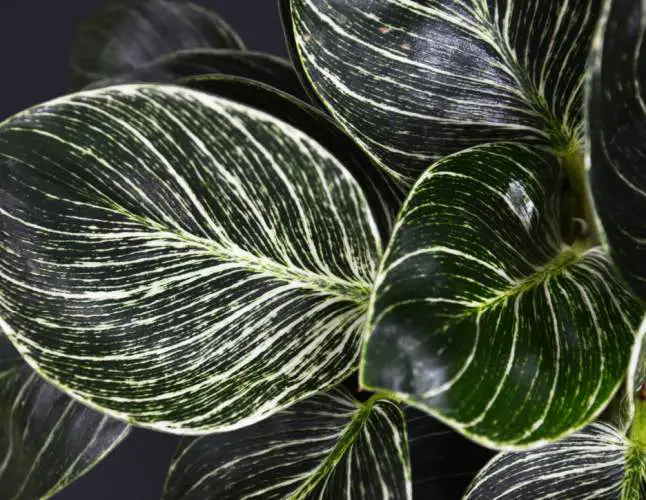
Dark green Philodendron Birkin leaf showing beautiful variegation with proper Birkin plant care
Bright indirect light promotes variegation, so if the Birkins don’t receive enough light their variegation will fade. However, keep in mind that direct sunlight can damage and scorch the leaves, so keep your Birkin away from too much direct sunlight. If you care for Philodendron Birkin properly, it will reward you with stable beautiful creamy variegation. You can check this blog post to learn more about what is indirect light for plants.
How Big Does Philodendron Birkin Grow?
Philodendron Birkin grows to 3 feet tall (91cm). Since it is known as a slow-growing plant, it can take a few years to grow fully.
Conclusion
If you follow all requirements, such as light, water, soil, temperature, and others, you will grow a beautiful Philodendron Birkin plant. Philodendron Birkin care guide will help you through that journey.
Yours Truly,


Related Posts
Sansevieria Black Gold (Snake Plant Care GUIDE!)
Spathiphyllum Sensation (FULLY Explained!)
Alocasia Stingray Care